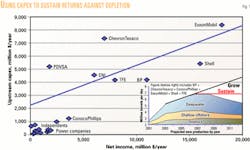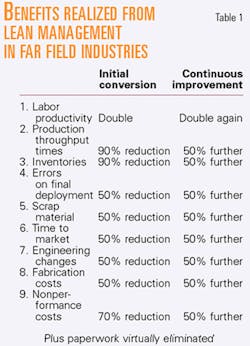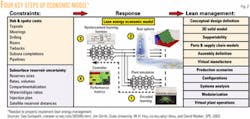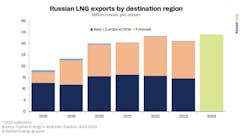Conversion to lean energy management will be required to insure economic development in ultradeepwater regions.
Software-controlled lean systems integration will drive innovation toward breakthrough cost and cycle-time savings. This move will utilize commercial-off-the-shelf (COTS) software widely used in the communications, chemical processing, aerospace, automotive, and other high-tech manufacturing industries but not yet used for lean management in the upstream energy industry.
Second and third parts of this series will appear here in weeks to come.
The grand challenge
The ultradeepwater is sorely in need of new lean energy management because costs and cycle times are too large to make development economical and the required capex is not sustainable.
Incremental change will not create the required breakthroughs. An example of the scope of the problem is that in lean manufacturing such as today's aerospace and automotive industries, the ratio of time spent in digital engineering design to that in actual construction is 5:1, whereas in the deepwater industry it is presently 1:5.
Lord Brown, chief executive officer of BP PLC, made the point in his keynote address at the 2001 Offshore Technology Conference.
The capital and operating expenses of designing, building, fabricating, drilling, installing, and operating for 20 years or more the 'offshore plants' used to produce the hard-to-get reserves in the ultradeepwater must be cut, not incrementally, but in half if we are to produce these new reserves to market.
Capex alone for ultradeepwater production facilities now ranges upwards of $1 billion for each offshore plant. And not just BP, but every supermajor, independent, and national oil company with deepwater margins is counting on these new reserves to sustain growth going forward (Fig. 1).
The critical component to ultradeepwater development is to reduce the cost of designing, fabricating, and operating the plants that will produce these resources to market.
A new "lean energy" management and economic model is required to move from the "silo-ed" project-by-project, design-then-execute methodology prevalent in the energy industry now to what other industries call "lean systems." Womack and Jones1 defined lean systems as "process and information integration across the enterprise, whatever it is."
Such a new e-define, e-manufacture, e-procure, and e-operate world of lean energy management will require a computer software infrastructure that is paperless (digital), shares a common database among all project participants (transparent), enforces integration, understands portfolio management and real options, learns, tracks key performance metrics of all actions, and is web-services based.
Only then will the infrastructure be collapsed sufficiently so that design, construction, and collaboration can be done from all over the world, all using COTS software.
Lean energy management
In order to implement lean energy methodologies, management and economic models must be constructed that integrate horizontal stages of development from appraisal, through planning, construction, and operations all the way to abandonment, with vertical levels in the organization from planning, through scheduling, supervisory control, regulation, reservoir management, engineering decisionmaking, and environmental impact.
Industries such as automotive, aerospace, pharmaceuticals, and the military have cut capex and opex costs and cycle times up to 25%/year through lean practices.2 3 4 Such a paradigm shift to lean energy systems will immediately affect cash flow and profitability of ultradeepwater developments to the same degree as in these other industries (Table 1).
Lean energy management and economic models require significantly more integrated software tools than are currently utilized by the petroleum industry to assure that all gaps are filled and connectivity maintained among a large number of contracted principals, as far-field industries have discovered over the last 20 years.
Lean processes have spread throughout not just the aerospace (Boeing and Lockheed Martin) and automotive (Ford and Toyota) industries but also in computers (IBM, Dell) and general manufacturing (GE and United Technologies).
Here are two key definitions.
"Reinforcement learning" is a fundamental property of the innervated infrastructure of future ultradeepwater deployments. It is designed to be built-in so that it is "free" and ubiquitous. In other words, learning must be designed into the system at a very fundamental level.
"Real options" are the financial calculus used in evaluation at the decision level. The option value is calculated using dynamic programming. Fundamentally, dynamic programming is a way of optimizing into the future, and real options are how choices are evaluated into the future.
Implementing the lean energy economic model (Fig. 2)
Step 1
Encode learning into a plant simulation model.
It is absolutely necessary that all levels of ultradeepwater "execution tree" understand and implement the lean practicum developed by these other industries. A model capable of simulating the operations of the plant is required. For example, reservoir uncertainties play a major role in shaping the core decisions that the plant must make throughout its life cycle.
Capturing the decision trees from actions to subsequent reactions are therefore central to accurate simulations necessary for proper evaluation of profitable production scenarios throughout the life cycle of ultradeepwater plants.
Columbia University uses a knowledge elicitation method we call the suitability matrix as a tool for building the lean practicum and populating the simulator. The suitability matrix captures and encodes the knowledge from best practices elicitations from experts and knowledge bases.
The suitability matrix tool set includes a user interface that uses 3D visualization and web-based explanation with a graphical user interface to collect feedback from the experts in each company.
Suitability matrices also perform gap analyses, problems-to-solutions tracking, and construction of a "House of Quality," a widely used method for mapping from customer requirements to product strategy. The latter contains the how, what, where, why, and how much information that is used to evaluate lean strategies and verify that there is no overlap of technologies or services.
Step 2
Develop real options capabilities for the economic model.
Real options are used in industries such as pharmaceuticals, aerospace, and on Wall Street as a guide to make quantitative evaluations of what is most likely to be useful to systems improvement through all life-cycle stages of a product. Decision and financial science disciplines must be developed and applied at all levels of the lean system in the energy industry, as well.5
Decisionmaking-under-uncertainty and conceptualization-to-product tools are absolutely necessary ingredients in the lean economic model. They include not only real options, gap analysis, house of quality, and suitability matrices (neural nets) but also EVA, balanced scorecards, and other more advanced metrics to actionable response tools such as the metrics thermostat and the virtual customer.
Step 3
Overlay a reinforcement learning harness.
Adaptive learning algorithms to "close the loop" are then required to assemble a lean, gap-free integration of these core business processes. Once process integration is wired, it can be measured and online adaptive learning algorithms used to first monitor, then learn, based on gradients in the processes measured.
Both the real option framework of Step 2 and the adaptive control in the learning harness of Step 3 have used dynamic programming as a means of evaluating future actions under uncertainty. These are then integrated into a reinforcement-learning-real-option evaluator that is then used to adapt and find systemic synergies among project efforts via simulations.
The learnings from this system are applied to broader use through the learning harness. Parallel design evaluations then allow the real option valuator to drive cross-system optimization. Processes can then be transferred literally to new development planning for the ultradeepwater.
Step 4
Create transparent performance metrics.
Performance metrics and their efficacy in tracking the improvements in innovation processes are critical to lean process improvement.
Traditional implementations like balanced score cards can be used with the learning harness to develop an adaptive control based metrics thermostat.
Implementing LEM
Assembled together, the encoded learning, real options reinforcement learning harness, and performance metrics tracking form an economic model that drives all management implementation decisions. Lean innovation management then has an economic model or "engine" that will continually address the following basic challenges:
The functional process-mapping cuts through much of the complexity that clouds understanding of the real drivers in product design, fabrication, and operation under constantly changing uncertainty.
It is easy to modify/update so that the mapping of new architectures can be incorporated easily to keep the fully integrated system dynamically viable.
The lean energy system builds a "held-in-common" process rigor for the ultradeepwater industry to advance the pace of innovation and couples this capability with the option to expand the system to enable broader collaborations and new "out-of-the-box" architectures.
Micro-options
In turn, lean energy management lays the foundation for silicon-based micro-options for the ultradeepwater in the future. Within the next several years, inexpensive silicon will be attached to every component of all complex systems in aerospace, automotive, and general manufacturing. These ubiquitous chips will have the following general characteristics:
Geo-located via GPS or other means such as wireless triangulation, inertial, etc. (There is the remaining challenge to communicate and geo-locate underwater components.)
Sensors, such as temperature, humidity, power consumption, light level, tilt, and acceleration will be incorporated into the silicon.
Product specifications—physical, operational, and fiscal. Eventually enough silicon to even simulate different uses for itself. The real options available to each component will be embedded in its own silicon, thus enabling micro-options.
2-way wireless (eventually UWB) to each component to form dynamic peer-to-peer, self-healing, aware networks. The network will bring the market to the last mile for real options valuation.
Grid computing using these networks will be used for real option evaluation of the hierarchical system of components. Plug and play modular design components will have a silicon face to them. These networks will be self-organizing and self-aware during the different phases of the lifecycle of a complex system deployment.
The enterprisewide use of these coming silicon-based micro-options for the ultradeepwater will include:
Design-build: The silicon will be created as the design of components develops. The silicon will form a grid-computing network to simulate the operation and to optimize design decisions. This includes the economic and risk side. Training on future operations will use this network.
Fabrication: The silicon will be attached to the component and will be used to track its completion. The master data base for the whole platform will be the embedded silicon in all the components being fabricated.
Shipping and deployment: When shipped, the silicon attached to each component will form a vigilant self-organizing network aware of intrusion, theft, alteration, etc. During deployment the attached silicon will be vigilant for dangerous or harmful situations caused by bad construction, assembly methods, or cheating by the contractor. It will also be vigilant for ISO 9000/14000 and other future standards in deployment.
Operation: Once deployed the system of components will form a sensing and computational grid that will monitor itself and its environment. Smart sensors and smart materials will form a vigilant system looking for variances from plan and simulating its own physical and economic performance.
Real options valuation of operational decisions will be done at the lowest level and propagated upwards through the system hierarchy. The peer-to-peer networked system will be able to simulate itself for adaptive control. Based on the reinforcement learning harness, the adaptive control will use dynamic programming to optimize its own operations.
Real options valuation will be used as metrics along with others such as regulatory measures for safety, MMS, environmental, and other regulations, etc. The master database of the operation will be the life-cycle silicon attached to each component.
Abandonment: The silicon will be vigilant for a safe and environmentally sound decommissioning and eventual recycling of certain components. Even in the scrap yard, the silicon has use.
In the future, the distinctions of the life-cycle phases will become blurred.
With lean energy management infrastructure in place and operational in the ultradeepwater, modular design, fabrication, assembly and operation will be driven by micro-options rigor and economic return-on-investment will skyrocket. The irony is that only such a "lean energy revolution" will make it truly affordable in the first place.
References
- Womack, J., and Jones, D., "Lean Thinking," Simon & Schuster, New York, 1996.
- Anderson, R.N., and Esser, W., "Energy Company as Advanced Digital Enterprise," American Oil & Gas Reporter, January 2001.
- Anderson, R.N., and Esser, W., "How to Operate an Advanced Digital Enterprise," Offshore Technology, October 2000.
- Saputelli, L., Cherian, B., Grigoriadis, K., Nikolaou, M., Oudinot, C., Reddy, G., Economides, M., and Ehlig-Economides, C., "Integration of Computer-Aided High-Intensity Design with Reservoir Exploitation of Remote and Offshore Locations," SPE 64621, 2000.
- HTTP://www.lucernex.com/ lucernexTech/rollOut.html.
Bibliography
Anderson, R.N., et al, "Quantitative tools link portfolio management with use of technology," OGJ, Nov. 30, 1998, p. 48.
Anderson, R.N., and Boulanger, A., "4-D Command-and-Control," American Oil & Gas Reporter, 1998.
Anderson, R.N., "Oil Production in the 21st Century," Sci. Am., Vol. 278, 1998, pp. 86-91.
Baldwin, C., and Clark, K., "Design Rules: The Power of Modularity," MIT Press, 2001.
Bertsekas, D.P., and Tsitsiklis, J.N., "Neuro-Dynamic Programming," Athena Scientific, 1996.
Economides, M., and Oligney, Ronald, "The Color of Oil," Round Oak Publishing, 2000.
Esser, W., and Anderson, R.N., "The Advanced Digital Enterprise in the Ultra-Deepwater Development," Offshore, October 2000.
Mathews, S.H., "Analyzing Engineering Projects Using Real Options¿Intelligent Investments in the Face of Uncertainty in the Boeing Company," (http://www.decisioneering.com/stories/boeing_ro.html).
Oligney, R., Longbottom, J., and M. Kenderdine, "Ultra-deepwater R&D Program Needed," Hart's E&P, 2001.
Smith, J., "Modeling and Valuing Real Options," (http://www.bus.utexas. edu/courses/MIS383N/Jim Smith presentation 4-5-2002.pdf).
Werbos, P.J., "Approximate Dynamic Programming for Real-Time Control and Neural Modeling," in White, D.A., and Sofge, D.A., eds., "Handbook of Intelligent Control," Van Nostrand, New York, 1992.
The authors
Roger N. Anderson ([email protected]) is Doherty Senior Scholar at Lamont-Doherty Earth Observatory, Columbia University, Palisades, NY. He is also director of the Energy and the Environmental Research Center (EERC). His interests include marine geology, 4D seismic, borehole geophysics, portfolio management, real options, and lean management.
Albert Boulanger is senior computational scientist at the EERC at Lamont-Doherty. He has extensive experience in complex systems integration and expertise in providing intelligent reasoning components that interact with humans in large-scale systems. He integrates numerical, intelligent reasoning, human interface, and visualization components into seamless human-oriented systems.
Jim Longbottom is director of the Ultra-Deepwater Research Initiative at the Texas Engineering Experiment Station, which is part of the Texas A&M University System. He has 23 years of experience in petroleum well completions, reservoir development processes, and commercialization with specialization in complex well architectures and system integration.
Ron Oligney is director of engineering research development and adjunct professor at the University of Houston. He previously held technical and executive positions within the Texas A&M University System, including assistant director of the Texas Engineering Experiment Station, and was director of the Aerospace Vehicle Systems Institute. He was principal and founding director of the Global Petroleum Research Institute.
Pain that Lean Energy Management and Economic Models address:- Eliminates the "Wish I could have seen it coming."
- Failure Models become predictive.
- Expedites cost out analyses.
- Estimates risk and return on all investments.
- Identifies solutions quickly.
- Selects only the most efficient processes.
- Verifies that work is being done on schedule and on cost.
- Eliminates latency in getting the right data to and from the right people.
- Improves the whole system performance for its whole life-cycle.









